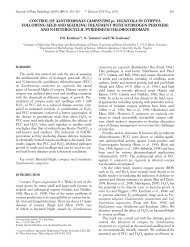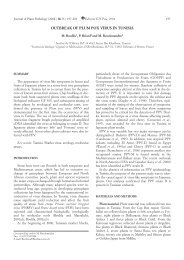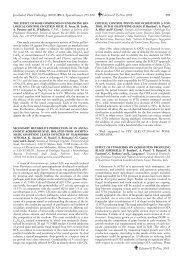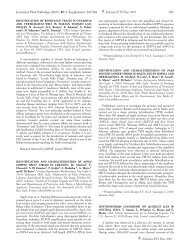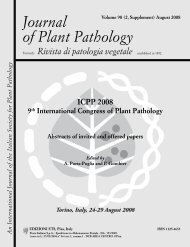Journal of Plant Pathology (2010), 92 (4, Supplement ... - Sipav.org
Journal of Plant Pathology (2010), 92 (4, Supplement ... - Sipav.org
Journal of Plant Pathology (2010), 92 (4, Supplement ... - Sipav.org
You also want an ePaper? Increase the reach of your titles
YUMPU automatically turns print PDFs into web optimized ePapers that Google loves.
<strong>Journal</strong> <strong>of</strong> <strong>Plant</strong> <strong>Pathology</strong> (<strong>2010</strong>), <strong>92</strong> (4, <strong>Supplement</strong>), S4.71-S4.105 S4.85<br />
(the fungus was never observed in Europe on the alternate host<br />
Larix sp.) was investigated under the scanning electron microscope<br />
(SEM). The dimension and morphology <strong>of</strong> urediniospores,<br />
the distribution <strong>of</strong> spines over the spore surface, and the other<br />
distinguishing features <strong>of</strong> this rust were examined in detail.<br />
PRESENCE AND ABUNDANCE OF ROOT ROT, BUTT<br />
ROT AND STEM ROT FUNGI IN PROTECTION<br />
FORESTS OF THE WESTERN ALPS. L. Giordano, G. Nicolotti,<br />
P. Gonthier. Dipartimento di Valorizzazione e Protezione<br />
delle Risorse Agr<strong>of</strong>orestali, Università degli Studi, Via Leonardo da<br />
Vinci 44, 10095 Grugliasco (TO), Italy. E-mail: paolo.gonthier@<br />
unito.it<br />
Protection forests have an important role in reducing the effects<br />
<strong>of</strong> natural hazards, such as avalanches, rock falls and debris<br />
flow. An adequate understanding <strong>of</strong> the disturbances that these<br />
forests may undergo is a prerequisite for the successful maintenance<br />
<strong>of</strong> the protection function. Wood decay fungi may affect<br />
the stability <strong>of</strong> trees and thus they may behave as natural disturbances.<br />
In this work we investigated the presence <strong>of</strong> root rot, butt<br />
rot and stem rot fungi in some protection forests <strong>of</strong> Piedmont<br />
and Aosta Valley (western Italian Alps). Tree species composition<br />
was variable depending on sites, and included both conifers and<br />
broadleaves. Fungi were identified through traditional techniques<br />
or DNA sequencing. The most frequent fungi were Fomitopsis<br />
pinicola, Heterobasidion annosum sensu lato and Stereum sanguinolentum.<br />
In a Norway spruce-dominated subalpine stand, approximately<br />
150 trees were sampled at the root collar by drilling<br />
them with a 4 mm diameter, 43 cm long bit. Fungal DNA was extracted<br />
from wood and analyzed by using universal and taxonspecific<br />
primers. The majority <strong>of</strong> the trees (56%) was infected by<br />
root and butt rot fungi. H. annosum sensu lato accounted for the<br />
70% <strong>of</strong> the infected trees, while Armillaria mellea sensu lato for<br />
8%. Remaining trees were infected either by both fungi or by unknown<br />
fungi. These results suggest that H. annosum sensu lato is<br />
by far the most frequent root and butt rot agent in the site.<br />
ALTERNATIVE HOSTS OF CASSAVA MOSAIC BEGO-<br />
MOVIRUSES IN TANZANIA. D. Guastella 1 , C. Busungu 2 , J.<br />
P. Legg 2 and M. Tessitori 1 . 1 Dipartimento di Scienze Fitosanitarie,<br />
Sezione Patologia Vegetale, Università di Catania, Via S. S<strong>of</strong>ia 100,<br />
95123 Catania, Italy. 2 IITA-Tanzania, P.O. Box 34441, Dar es<br />
Salaam, Tanzania. E-mail: mtessitori@unict.it<br />
Cassava mosaic disease (CMD), the most important disease <strong>of</strong><br />
this staple food crop in Africa, is caused by eight cassava mosaic<br />
begomoviruses (CMBs), seven <strong>of</strong> which occur in Africa. All viruses<br />
involved in the disease are efficiently transmitted in the field<br />
by Bemisia tabaci. Cassava was introduced to Africa in the 16 th<br />
century, so it is recognized that this crop must have become infected<br />
by CMBs originating from wild African plant species. To<br />
date, however, little is known about the wild hosts <strong>of</strong> CMBs. This<br />
is an important shortcoming, since wild hosts may potentially<br />
play a significant role in the epidemiology <strong>of</strong> CMD. During a<br />
May <strong>2010</strong> survey that covered about 50,000 km 2 <strong>of</strong> north-western<br />
Tanzania, more than 30 samples were collected from different<br />
species <strong>of</strong> weeds or cultivated plants showing mosaic symptoms.<br />
PCR using universal primers (UniF and UniR) confirmed the association<br />
<strong>of</strong> wild cassava (Manihot glaziovii) with CMBs in Tanzania.<br />
Moreover, new hosts <strong>of</strong> these viruses were identified, i.e.<br />
Combretum confertum, Arachis hypogaea, Hibiscus cannabinus,<br />
Leucaena leucocephala and Conyza sumatrensis. Subsequent PCR<br />
by specific primers for both African cassava mosaic virus (ACMV)<br />
and East African cassava mosaic virus (EACMV) allowed the identification<br />
<strong>of</strong> specific virus infections. L. leucocephala and C. sumatrensis<br />
were infected by both ACMV and EACMV. Sequencing<br />
studies are currently underway to further characterize these novel<br />
CMB infections <strong>of</strong> non-cassava hosts.<br />
BOTRYOSPHAERIA SPECIES ASSOCIATED WITH ESCA-<br />
DISEASED GRAPEVINE IN SOUTHERN ITALY AND<br />
LEBANON. W. Habib, S. Pollastro, F. Faretra. Dipartimento di<br />
Protezione delle Piante e Microbiologia Applicata, Università degli<br />
Studi “Aldo Moro”, Via Amendola 165/A, 70126 Bari, Italy. Email:<br />
faretra@agr.uniba.it.<br />
Botryosphaeriaceae are fungi frequently isolated from vines<br />
showing decline or dieback symptoms in several countries. Wood<br />
symptoms such as cankers, sectorial V-shaped necroses in wood,<br />
bud mortality, shoot dieback and graft union failure have been<br />
associated with different species <strong>of</strong> Botryosphaeriaceae, and different<br />
disease names have been given to certain types <strong>of</strong> symptoms.<br />
In particular, in Mediterranean countries, black dead arm<br />
(BDA) was retained an important vine-decline disease in addition<br />
to Eutypa dieback and esca. In the present work, morpho-taxonomic<br />
characterization and sequence analysis <strong>of</strong> rDNA internal<br />
transcribed spacer regions (ITS) were used to identify<br />
Botryosphaeriaceae isolates obtained from esca-affected vines in<br />
Apulia (southern Italy) and Lebanon. According to the morphotaxonomic<br />
approach, three main groups <strong>of</strong> isolates were recognized:<br />
(i) characterized by pigmented, thick-walled conidia, including<br />
the genera Diplodia, Lasiodiplodia, and Dothiorella; (ii)<br />
characterized by hyaline, thin-walled conidia, comprising the<br />
genera Fusicoccum and Ne<strong>of</strong>usicoccum; (iii) isolates which did not<br />
differentiate conidia in culture. Molecular identification <strong>of</strong><br />
Botryosphaeriaceae species was based on the comparison <strong>of</strong> ITS<br />
sequences with those available in GenBank. In agreement with<br />
the results obtained in other countries, 55 tested isolates were<br />
identified as Diplodia seriata (32.7%), Ne<strong>of</strong>usicoccum parvum<br />
(30.9%), Fusicoccum aesculi (12.7%), Ne<strong>of</strong>usicoccum australe<br />
(9.1%), Ne<strong>of</strong>usicoccum luteum (5.5%), and Ne<strong>of</strong>usicoccum vitifusiforme<br />
(3.6%). The species Dothiorella viticola, Diplodia mutila,<br />
and Lasiodiplodia theobromae were represented by one isolate<br />
each. Further studies on the distribution and pathogenicity <strong>of</strong><br />
Botryosphaeriaceae fungi are therefore essential to clarify their<br />
possible role in grapevine decline.<br />
RAPD ANALYSIS IN BOTRYOSPHAERIACEAE FUNGI.<br />
W. Habib, S. Pollastro, F. Faretra. Dipartimento di Protezione<br />
delle Piante e Microbiologia Applicata, Università degli Studi “Aldo<br />
Moro”, Via Amendola 165/A, 70126 Bari, Italy. E-mail: faretra@agr.uniba.it.<br />
For a long time, taxonomic studies on Botryosphaeriaceae<br />
fungi were based on morphological characters which exhibit high<br />
variability. Host specificity cannot be <strong>of</strong> help as a taxonomic criterion<br />
since several host plants can be colonized by a single fungal<br />
species and different species can occur on the same host<br />
plant. In the present study, 55 isolates <strong>of</strong> Botryosphaeriaceae fungi<br />
(Diplodia mutila, Diplodia seriata, Dothiorella viticola, Fusicoccum<br />
aesculi, Lasiodiplodia theobromae, Ne<strong>of</strong>usicoccum australe,<br />
Ne<strong>of</strong>usicoccum luteum, Ne<strong>of</strong>usicoccum parvum, Ne<strong>of</strong>usicoccum vitifusiforme)<br />
were collected from standing vines showing symptoms<br />
<strong>of</strong> cankers, dieback and esca in commercial vineyards and<br />
from rootstocks in nurseries <strong>of</strong> southern Italy and Lebanon.



